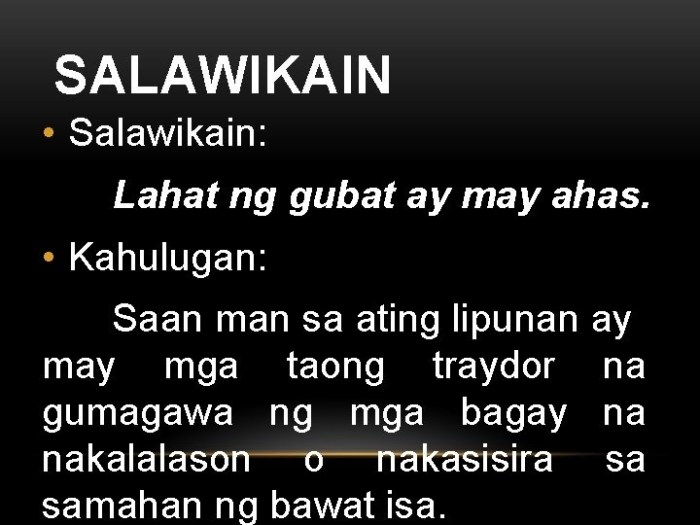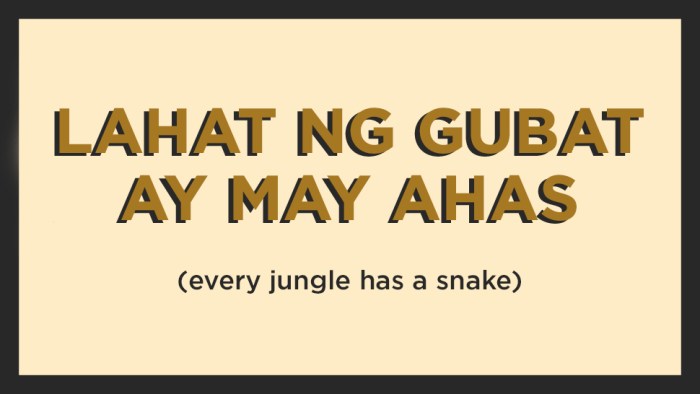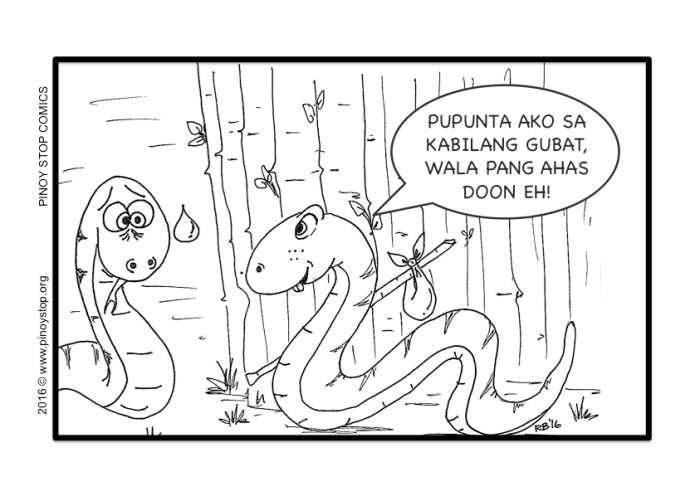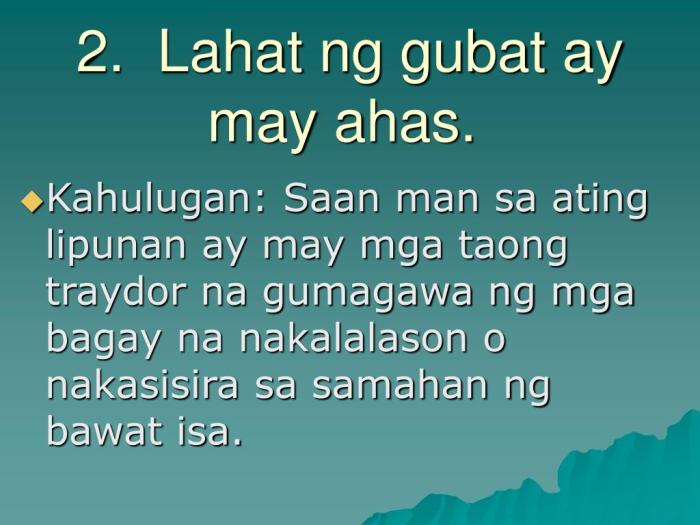Embarking on an exploration of the enigmatic phrase “lahat ng gubat ay may ahas,” we delve into a realm of metaphorical richness and cultural significance. This proverb, deeply ingrained in the Filipino psyche, offers a lens through which we can examine the complexities of life, the hidden lessons it imparts, and the enduring wisdom it holds.
Beyond its literal interpretation, “lahat ng gubat ay may ahas” invites us to explore the metaphorical depths it conceals. It cautions us of the potential dangers that lurk in even the most alluring places, reminding us to tread carefully and be ever vigilant.
Literal Meaning

The phrase “lahat ng gubat ay may ahas” translates to “every forest has a snake.” This means that it is common to find snakes in forests, and that one should be aware of their presence when entering a forest.
This meaning can be applied in real-life situations in a number of ways. For example, if you are planning to go hiking in a forest, you should be aware that there is a chance that you may encounter a snake.
The old saying goes, “lahat ng gubat ay may ahas.” In other words, no matter where you go, there are always going to be challenges. Just like in math, sometimes you’ll come across a problem that seems impossible to solve.
But don’t worry, there’s always a solution. You can find pert math test answer key online that can help you understand the concepts and solve the problems. So remember, even in the most challenging situations, there’s always a way to find the answer.
You should take precautions to avoid being bitten, such as wearing long pants and boots, and carrying a walking stick.
Examples
- If you are walking through a forest and you see a snake, you should not panic. Remain calm and slowly back away from the snake.
- If you are bitten by a snake, you should seek medical attention immediately.
- If you are concerned about snakes, you can take precautions to avoid being bitten, such as wearing long pants and boots, and carrying a walking stick.
Metaphorical Meaning

The phrase “lahat ng gubat ay may ahas” carries a metaphorical significance beyond its literal interpretation. It serves as a cautionary adage, conveying hidden meanings and lessons that apply to various aspects of life.
This metaphorical interpretation suggests that danger and potential threats lurk in even the most seemingly innocuous places. Just as snakes can be concealed amidst lush greenery, so too can hidden perils reside within seemingly safe environments.
Hidden Dangers
The phrase warns against complacency and the assumption that all is well. It reminds us to be vigilant and aware of potential risks, even when things appear calm and peaceful. By acknowledging the presence of “snakes” in our lives, we can take necessary precautions to protect ourselves from harm.
Hidden Intentions
Metaphorically, the “snakes” can also represent individuals with malicious intent or hidden agendas. The phrase cautions us to be wary of those who may appear friendly or trustworthy on the surface but harbor ulterior motives. It encourages us to exercise caution and discernment in our interactions, especially with those we do not know well.
Overcoming Challenges
The phrase can also be interpreted as a metaphor for the challenges and obstacles we face in life. Just as snakes can be a hindrance in the forest, so too can difficulties hinder our progress. However, the phrase reminds us that even in the face of adversity, we must persevere and seek ways to overcome the “snakes” that block our path.
Cultural Significance
In Philippine society, the phrase “lahat ng gubat ay may ahas” holds significant cultural significance, reflecting deeply ingrained beliefs and traditions.
This phrase serves as a metaphorical warning against potential dangers lurking within seemingly familiar or comfortable situations. It cautions individuals to be wary of hidden threats and to approach new experiences with caution.
Beliefs and Folklore
The phrase has influenced Filipino beliefs and folklore, shaping how people perceive the world around them. It is believed that even in the most mundane or ordinary places, there may be hidden dangers or obstacles that can arise unexpectedly.
This belief is often reflected in Filipino folklore, where stories and legends often involve characters encountering hidden dangers in seemingly safe environments. These stories serve as cautionary tales, reminding people to be vigilant and to trust their instincts.
Artistic Representations

The phrase “lahat ng gubat ay may ahas” has found its way into various forms of Philippine art, enriching its meaning and impact.
In Literature
In Philippine literature, the phrase appears in the works of renowned authors like José Rizal and Amado V. Hernandez. Rizal’s novel “Noli Me Tangere” features a character named Sisa who uses the phrase to warn her sons about the dangers lurking in the forest.
Hernandez’s poem “Ang Panday” employs the phrase metaphorically, comparing the Philippine countryside to a dangerous jungle where the “ahas” represent oppressive forces.
In Music
Philippine folk songs often incorporate the phrase “lahat ng gubat ay may ahas.” The song “Ako ay May Singsing” features the lyrics “Lahat ng gubat ay may ahas, lahat ng bundok ay may tigre,” highlighting the dangers and challenges that lie ahead.
Another song, “Magtanim Ay Di Biro,” uses the phrase to emphasize the need for caution and vigilance in life’s journey.
In Art
The phrase has also inspired visual artists. In the painting “Lahat ng Gubat ay May Ahas” by Fernando Amorsolo, a woman is depicted walking through a dense forest, surrounded by lurking snakes. The painting serves as a reminder of the hidden dangers that may exist even in seemingly safe places.These
artistic representations contribute to the phrase’s overall meaning and impact by:*
-*Illustrating its literal meaning
They depict the physical dangers present in the natural world, reinforcing the need for caution and awareness.
-
-*Expanding its metaphorical significance
They extend the phrase’s meaning to encompass social, political, and personal contexts, highlighting the potential threats and obstacles that may arise.
-*Reinforcing its cultural significance
By incorporating the phrase into their works, artists connect it to the collective Filipino experience, fostering a sense of shared understanding and caution.
Variations and Adaptations

The phrase “lahat ng gubat ay may ahas” has undergone various changes and adaptations over time, resulting in new interpretations and uses.
One common variation is the addition of specific types of snakes, such as “lahat ng gubat ay may ahas na makamandag” (every forest has a venomous snake). This variation emphasizes the potential danger lurking in forests, highlighting the presence of venomous snakes that can pose a threat to humans and animals alike.
Geographic Variations
The phrase has also been adapted to different geographical contexts. For instance, in the Philippines, it is common to say “lahat ng gubat ay may tikbalang” (every forest has a tikbalang), referring to a mythical creature said to inhabit forests and mountains.
These variations reflect the cultural beliefs and folklore associated with different regions, adding depth and nuance to the original phrase.
Modern Interpretations

In contemporary Philippine society, the phrase “lahat ng gubat ay may ahas” has undergone a subtle yet significant shift in interpretation. While the literal meaning remains intact, its metaphorical significance has expanded to encompass a broader range of societal issues.In
the modern context, the phrase serves as a cautionary reminder that even the most seemingly idyllic or prosperous environments can harbor hidden dangers or threats. It highlights the importance of being vigilant and discerning, particularly in situations where one might be tempted to let their guard down.
Application in Social and Political Contexts, Lahat ng gubat ay may ahas
The phrase has gained particular relevance in the context of social and political dynamics. It is often invoked to warn against the presence of corrupt or malicious individuals within seemingly reputable organizations or institutions. By extension, it cautions against the dangers of blind trust and the need for critical thinking when evaluating the intentions and actions of others.
Application in Personal Relationships
The phrase also finds application in the realm of personal relationships. It serves as a reminder that even within close and intimate relationships, there may be hidden motives or potential for betrayal. It emphasizes the importance of maintaining a healthy level of skepticism and being aware of the potential risks involved in interpersonal interactions.
FAQ Explained: Lahat Ng Gubat Ay May Ahas
What is the literal meaning of “lahat ng gubat ay may ahas”?
It means that every forest has snakes, implying that there is always a potential for danger or difficulty lurking in any situation.
How is “lahat ng gubat ay may ahas” used metaphorically?
Metaphorically, it suggests that even in seemingly safe or pleasant situations, there may be hidden risks or challenges that need to be considered.